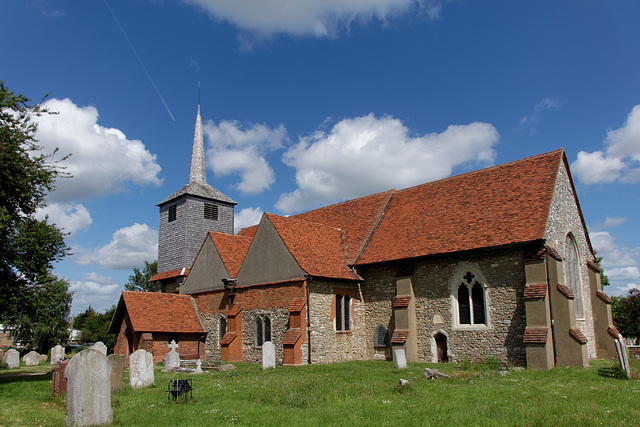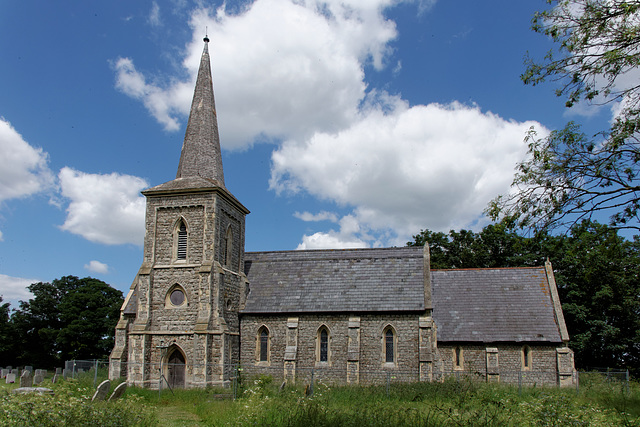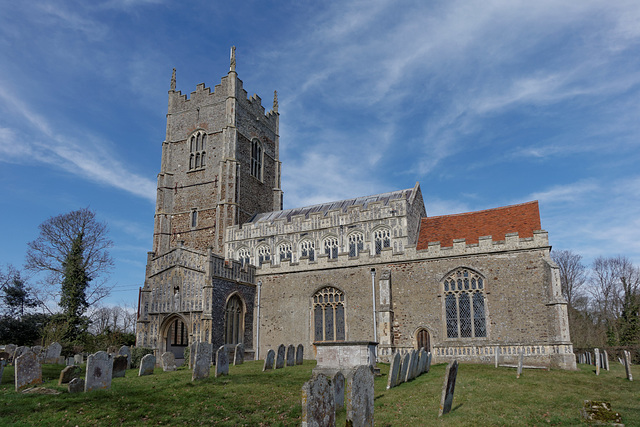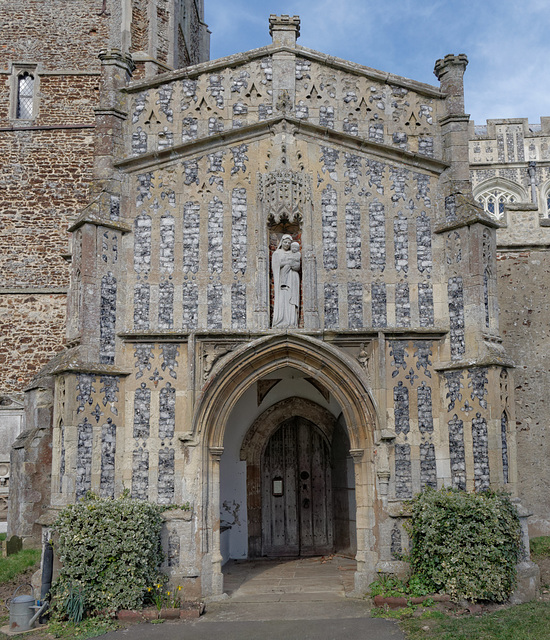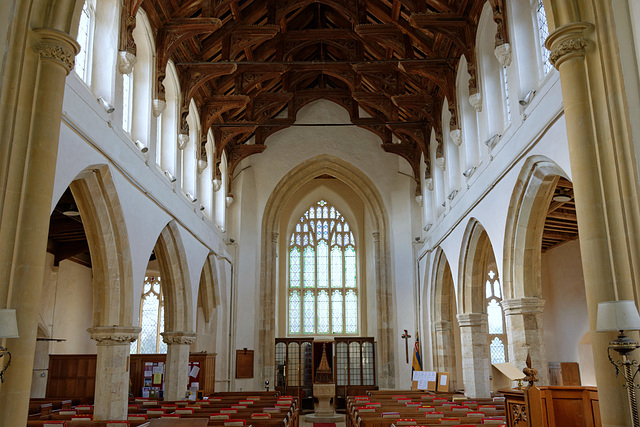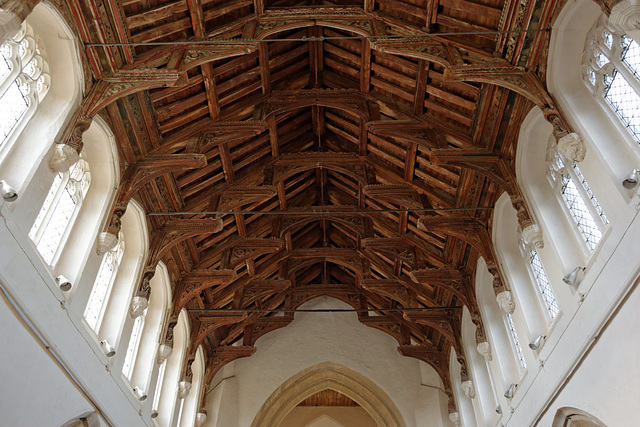
Essex Churches (D - I)
Folder: Churches in Essex
Danbury - Downham
Earls Colne - Epping
Fairstead - Fyfield
Gestingthorpe - Greensted
Hadleigh - Hutton
Ingatestone - Ingrave
Earls Colne - Epping
Fairstead - Fyfield
Gestingthorpe - Greensted
Hadleigh - Hutton
Ingatestone - Ingrave
Eastwood - St Laurence and All Saints
The south aisle of the church has a distinctive 16th century brick porch with matching rendered gables alongside it. Below the gables, the upper part of the rubble walls have been rebuilt in brick.
The nave is Norman, c.1100, with the south aisle and tower added in the 13th century when the chancel was rebuilt. The timber bell turret is 18th century.
Eastwood Church, Essex
Eastwood - St Laurence : Graves
In the early 19th century, steel cages known as mortsafes were used to protect the graves from grave-robbers, so-called 'resurrectionists'. The Anatomy Act of 1832 meant that bodies could be more easily procured for medical dissection, although the stealing of corpses still continued for some years after.
Foulness - St Mary the Virgin
Foulness Island has a population of around 160 and is normally closed to non-residents, as it belongs to the Ministry of Defence. A School of Gunnery was established there in 1859 and since 2003 a private firm has been testing munitions under contract on the many firing ranges on the island. Like the village pub, the church is now closed. The dwindling population has no need for a church, the structure of which is now deemed unsafe: the isolated and potentially hostile environment of the island a fitting match to the ailing Victorian folly. View of Foulness Church from north
Foulness - St Mary the Virgin
Built in 1853 by William Hambley in Early English Style, this large village ragstone church replaced an earlier one from 1550. Now closed and in poor repair.
07 Mar 2015
1 comment
Great Bromley - St George
A superb Grade I listed church, sited on a rise at the heart of the village. The nave, chancel and south aisle were built in the early 14th century although the chancel was substantially restored in 1867. The tower, nave, north aisle, and porch are 15th century. The clerestory and magnificent double hammerbeam roof were added in around1500.
The tower contains a surprising amount of puddingstone, cheap and evidently plentiful locally. The south porch and clerestory however consist of very fine knapped flint flushwork - although the flint was readily available, the flushwork required specialist skills. Knapped flushwork is also present on the tower and in a frieze around the base of the chancel. The south, north and west doors, also all around 1500, have remnants of intricate carved tracery.
This church is far more elaborate than you would expect from an Essex village church, and Pevsner called it "the Cathedral of the Tendring Hundred"
For a virtual tour of St George's: 3D panorama of St George's
07 Mar 2015
Great Bromley - St George
The porch was built in the 15th century. The attractive panelling is made from knapped flint flushwork. At the front is a parapet, and there are battlements on each side. In the spandrels of the porch are carvings of St George and the dragon: within the porch, spandrel figures of Adam and Eve have been re-set over the church doorway. The niche statue of Madonna and child is by H & K Mabbitt, 1956.
07 Mar 2015
1 comment
Great Bromley - St George
The nave, looking west towards the tower arch and font. The main body of the church - nave, chancel, and south aisle - was built early in the 14th century, with the north aisle added in the 15th century. The nave is high and spacious and full of ligh, thanks to the 7-bay clerestory which was built in around 1500 at the same time as the double hammerbeam roof.
The south aisle has two pillars. One is decorated with carved leaves and the other, with extraordinary figures of humans, animals and grotesque devilish creatures, an example of which is shown as a pop-up.
The tower arch is remarkable: it frames the west window beautifully and reaches the top of the clerestory.
07 Mar 2015
Great Bromley - St George
The nave, looking east towards the chancel. The main body of the church - nave, chancel, and south aisle - was built during the fourteenth century. The south aisle has two pillars. One is decorated with carved leaves and the other, with extraordinary figures of humans, animals and grotesque devilish creatures.
The north aisle was added in the 15th century. The whole nave is high and spacious and full of light thanks to the elegant clerestory added c.1500. The double hammerbeam roof was built at the same time. The chancel was restored in 1867, by T W Nunn.
07 Mar 2015
Great Bromley - St George
A stunning double hammerbeam roof spans the nave. It dates from c.1500 and was once brightly painted. Traces of this paintwork can still be seen at the eastern end. The stone corbels are carved with angels, and the braces terminate with carved defaced images of saints. The elegant, 7-bay clerestory was built at the same time as the roof.
Pevsner calls this "one of the most magnificent roofs of Essex". This image is looking west, towards the tower.
Jump to top
RSS feed- Latest items - Subscribe to the latest items added to this album
- ipernity © 2007-2024
- Help & Contact
|
Club news
|
About ipernity
|
History |
ipernity Club & Prices |
Guide of good conduct
Donate | Group guidelines | Privacy policy | Terms of use | Statutes | In memoria -
Facebook
Twitter

